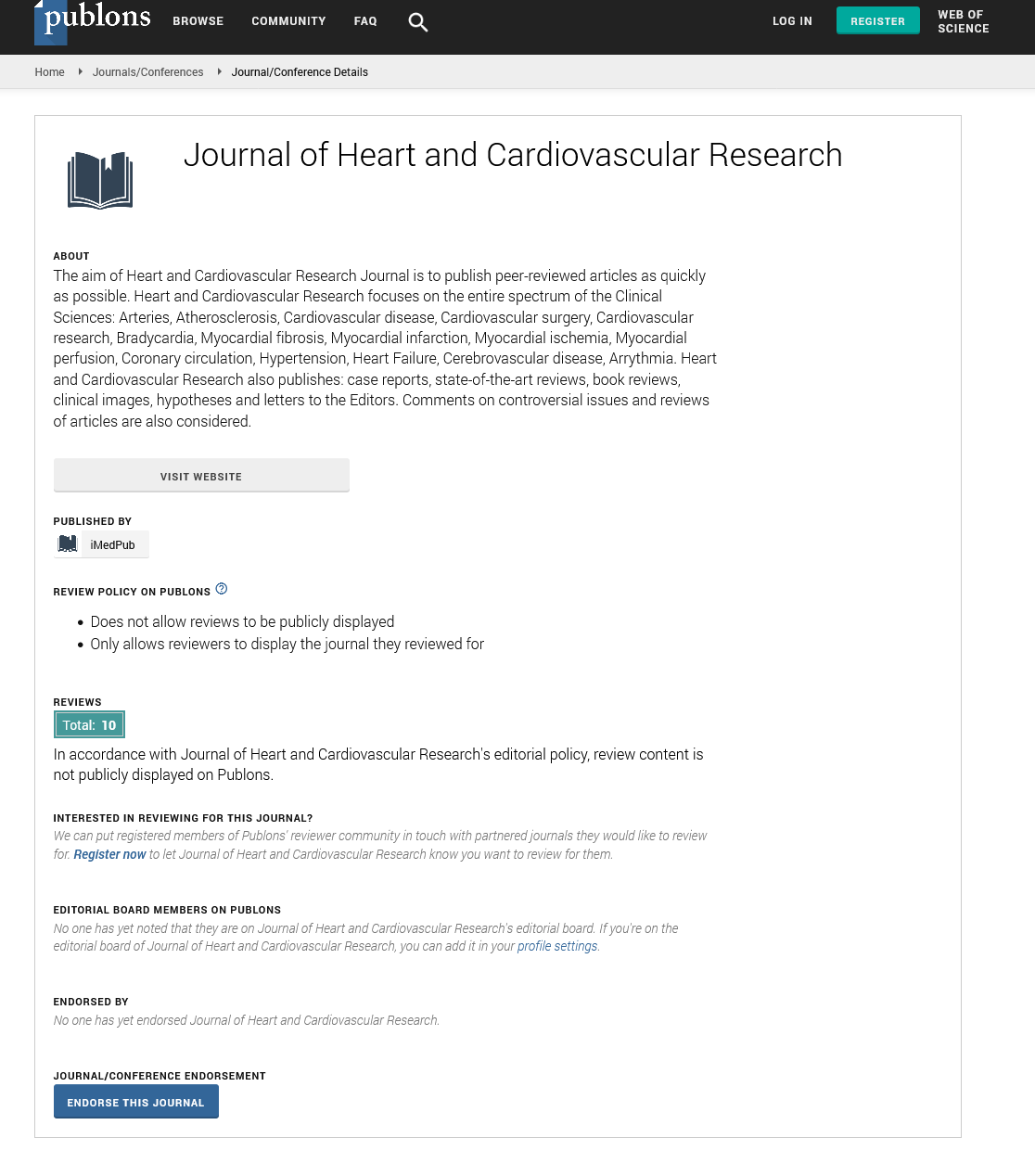ISSN : ISSN: 2576-1455
Journal of Heart and Cardiovascular Research
Abstract
Cardiology 2019: Prevalence and factors related with inter-arm blood pressure difference in hypertensive elderly in Yasothon province - Khosuk S - Institute of Khon Kaen University
Increase of systolic blood pressure difference between arms was associated with increased risk of atherosclerosis and also identified as a predictor of cardiovascular event and mortality. The aim of this study was to investigate the prevalence of an inter-arm systolic blood pressure difference (sIAD) in hypertensive elderly and to identifity what factors include participant’s characteristic and physical performance between individual who have normal and abnormal sIAD, who living at Yasothon province, Thailand. This study was conducted cross sectional study from review medical data and selected 196 hypertensive elderly without cardiovascular disease and who met inclusion criteria (average age 71.74 ± 6.58 years, 54.08% women, 68.37% never smoked). Blood pressure was recorded randomly sequential technique for each arm using an automated oscillometric device. The sIAD was expressed as the absolute systolic blood pressure, and difference were determined for individual subject, was calculated by subtracting the right arm systolic blood pressure (R) from the left arm (L) (|R-L|). Participants were evaluated vascular status by sIAD and physical performance was assessment by hand grip strength. The prevalence of an abnormal sIAD will report as a percentage and compared the between group was used Student t-test, differences were considered to be statistically significant where p < 0.05. The prevalence of abnormal sIAD (defined as sIAD ≥ 10 mmHg) was 17 (8.67%) participants. Number of participant who reported smoke habit (ex-smoker and current smoker) together with resting systolic blood pressure were significantly higher in participants who had abnormal sIAD group (p < 0.05). The results instruct there is considerable that abnormal sIAD in the hypertensive elderly, which was risk factor for cardiovascular disease. Thus, in primary care may applied blood pressure measurement as a simple tool for assessment of cardiovascular status in Thai community population.
The between arm distinction (IAD) in circulatory strain (BP) has gotten consideration all around was found by Osler in 1915 who noted first.The pulse ought to be estimated in both the arms at the principal visit since contrasts exist and estimation in just one arm may prompt under analysis of hypertension. Hypertension rules suggest that pulse ought to be surveyed in the two arms at the underlying visit. The IAD in BP has gotten expanding consideration as of late on the grounds that it has seen as related with fringe vascular infection however the avocation has been poor and selection in essential consideration practice insignificant to date. The significance of estimating pulse in the two arms is at first to forestall the misdiagnosis of hypertension because of typical contrasts in circulatory strain between the arms.
Right and left arm contrasts of a couple of mm of Hg are very ordinary, yet beyond what 10 mm of Hg could fundamentally build the hazard for cardiovascular results, including expanded cardiovascular mortality and all-cause mortality and IAD is related with expanded cardiovascular horribleness. The arm with the higher qualities ought to be utilized for resulting estimations was proposed by current rules for the administration of hypertension. The circulatory strain contrasts between arms are reproducible along these lines the BP arm ought to be pre-indicated. IAD is seen with a noteworthy increment in circulatory strain whether it is systolic or diastolic, was estimated unequivocally critical and is more prominent in hypertensive subjects and in patients with fringe blood vessel infection.
At the point when the two arms are estimated, it has been proposed that synchronous estimation of the two arms appears to be ideal since consecutive estimation of BP overestimates the predominance of systolic IAD. The distinctions have prognostic significance and the degree to which these distinctions are reproducible is obscure. Contrasts between arms are reproducible, however regularly have varieties, accordingly; the BP arm ought to be pre-indicated. A normal of at any rate three perceptions of circulatory strain ought to be utilized to recognize the entomb arm pulse distinction in the left and right arm of patients determined to have serious maladies. The arms ought not be utilized conversely to acquire BP chronicles at rehashed visits.
Author(s): Khosuk S
Abstract | PDF
Share This Article
Google Scholar citation report
Citations : 34
Journal of Heart and Cardiovascular Research received 34 citations as per Google Scholar report
Journal of Heart and Cardiovascular Research peer review process verified at publons
Abstracted/Indexed in
- Google Scholar
- Sherpa Romeo
- China National Knowledge Infrastructure (CNKI)
- Publons
Open Access Journals
- Aquaculture & Veterinary Science
- Chemistry & Chemical Sciences
- Clinical Sciences
- Engineering
- General Science
- Genetics & Molecular Biology
- Health Care & Nursing
- Immunology & Microbiology
- Materials Science
- Mathematics & Physics
- Medical Sciences
- Neurology & Psychiatry
- Oncology & Cancer Science
- Pharmaceutical Sciences
